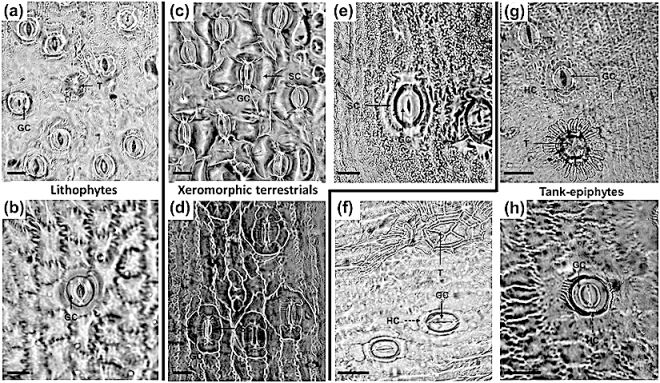Photo credit: Google
Bromeliad species used in this investigation: (a) Pitcairnia integrifolia, (b) Pitcairnia xanthocalyx, (c) Puya berteroniana, (d) Puya mirabilis, (e) Ochagavia elegans, (f) Guzmania lingulata, (g) Lutheria glutinosa, and (h) Nidularium innocentii. Photos (a), (f), and (g) are by JM; (b) by Tony Rodd (CC BY-NC-SA 2.0); (c) by Sean O’Hara (CC BY 2.0); (d) and (h) by Timm Stolten (CC BY-SA 3.0); and (e) by Jardín Botánico Nacional de Chile (CC BY-NC 2.0). [Colour figure can be viewed at wileyonlinelibrary.com]
Specialized stomatal humidity responses underpin ecological diversity in C3 bromeliads
by Males J., Griffiths H. (2017)
Department of Plant Sciences, University of Cambridge, Cambridge, UK
Jamie Males, Howard Griffiths,
in Plant, Cell & Environment, doi: 10.1111/pce.13024. –
http://onlinelibrary.wiley.com/doi/10.1111/pce.13024/full

Abstract
The Neotropical Bromeliaceae display an extraordinary level of ecological variety, with species differing widely in habit, photosynthetic pathway and growth form. Divergences in stomatal structure and function, hitherto understudied in treatments of bromeliad evolutionary physiology, could have been critical to the generation of variety in ecophysiological strategies among the bromeliads.
Because humidity is a key factor in bromeliad niches, we focussed on stomatal responses to vapour pressure deficit (VPD). We measured the sensitivity of stomatal conductance and assimilation rate to VPD in eight C3 bromeliad species of contrasting growth forms and ecophysiological strategies and parameterised the kinetics of stomatal responses to a step change in VPD.
Notably, three tank-epiphyte species displayed low conductance, high sensitivity and fast kinetics relative to the lithophytes, while three xeromorphic terrestrial species showed high conductance and sensitivity but slow stomatal kinetics.
An apparent feedforward response of transpiration to VPD occurred in the tank epiphytes, while water-use efficiency was differentially impacted by stomatal closure depending on photosynthetic responses.
Differences in stomatal responses to VPD between species of different ecophysiological strategies are closely linked to modifications of stomatal morphology, which we argue has been a pivotal component of the evolution of high diversity in this important plant family.
